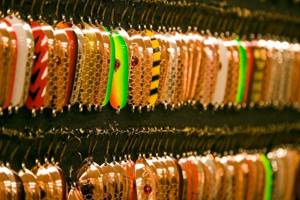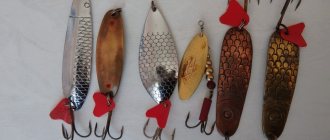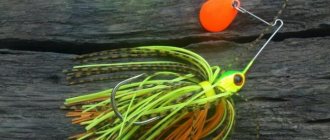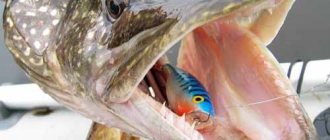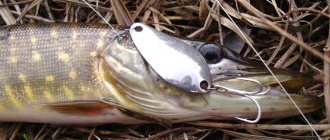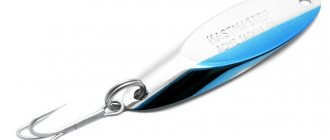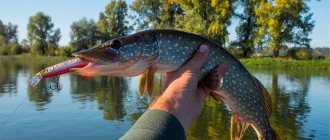Design of a pike jig
An oscillating spoon is a curved metal plate of oval or elongated shape. There is one hole each in the upper and lower parts of this plate; a fishing line is attached to the upper hole through the winding ring and swivel; a hook is attached to the lower hole, also through the winding ring. The swivel is placed in the upper part of the spoon between the winding ring and the fishing line; this is done so that the spoon does not twist the fishing line.
A variety of metals can be used to make oscillating spoons: steel, copper, brass or lead. The surface of the spoon can be simply sanded; in addition, it can be coated with enamel, chrome or nickel. The color of the spoon and its shine will depend on the metal of the spoon itself and the type of coating.
Oscillating spoons can come in a variety of shapes: wide, narrow, flattened and elongated. The choice of color and shape of the spoon depends on the reservoir where fishing is carried out and the fishing conditions.
The oscillating spoon imitates a fish that is fleeing from a predator pursuing it. The appearance of the spinner plays a secondary role compared to the performance of the spinner. Predatory fish, in pursuit of their prey, are primarily oriented by the lateral line organ, which perceives the vibration coming from the prey, and only secondarily by vision. This is why the correct play of an oscillating spoon in the water is so important; a good quality play distinguishes a high-quality bait from a cheap Chinese fake.
The nature of the game depends on the design of the spinner. The optimal spinner for pike fishing often has a length to width ratio of 3 to 4. Shorter spinners, which have a smaller length to width ratio, have a more energetic action, but their action is less stable, and they often become erratic as the reel speed increases. rotate. Long spoons with a larger length-to-width ratio have a less energetic game; often such spoons are curved both in length and width.
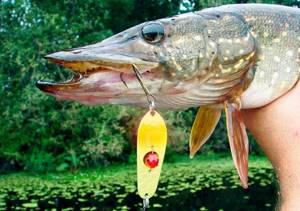
The spoon can be equipped with different types of hooks. Most often, the oscillating spoon is equipped with a tee, but there are spoons with a double or even a single hook installed. If a tee is installed on the spoon, then its width should be equal to the width of the lower part of the spoon. The weight of the hook should not be too heavy. A hook that is too heavy disrupts the play of the spinner, the spinner loses its play and simply drags on the fishing line.
In some spinners, a thin red plastic petal is hung on the winding ring to which the tee is attached; it masks the hook of the spinner and makes the spinner more attractive to a predator, thereby increasing its catchability.
Pike often have to be caught in heavily overgrown with grass and snags; this is where an oscillating, non-hooking spoon becomes indispensable. The non-hook can have a single hook, rigidly soldered to the spoon. Sometimes, in order to make the spoon even more snag-free at the bottom, a loop or double antennae made of steel wire are soldered on, which protect the hook tip from snagging.
There are a huge number of spinners on sale; choosing the right spinner is quite difficult. When choosing a spoon for pike, you need to take into account many factors: the nature of the reservoir where fishing is done, time of year and time of day, weather conditions during fishing. The choice of spoon is made by anglers through trial and error.
Advantages and disadvantages
For many centuries, fishermen have been arguing about the catchability of one or another bait, each of which has pros and cons. The main criteria are casting range, price, catchability, color, functionality. Spoon baits are superior to other types of bait in many ways, but they also have their drawbacks.
To learn more:
Using makukha for fishing
Advantages of oscillating spinners:
- Catchability. Since Soviet times, “hardware” has been valued due to its high percentage of bites sold. The tee, which is suspended on the winding ring, does not give the fish a single chance.
- Functionality. The same model can be used for fishing both in the bottom layer and on the surface.
- Variety of wiring. A wide range of applications is distinguished by several basic animations: step, uniform and jerky (twitch).
- Visibility. Many models are not painted, and the bare metal is visible from a long distance. In muddy water, spinners have no equal.
- Durability. As mentioned earlier, the material does not deteriorate, and the grip of the same pike does not harm the steel coating.
For fishing in snags, there are specialized “non-hooking” hooks that have one or two whiskers that cover the hook tip. In addition to all of the above, many manufacturers add a “Prices” item when describing their products. Perhaps 10 years ago it was moderate, but today you have to pay for a decent catching model.
Main disadvantages
The main disadvantage is the aerodynamic property of the iron nozzle. In calm weather, even the most experienced spinning angler will not be able to accurately place the bait in the right place. This is due to the special shape of the spinners and windage, which is formed during casting. In open waters, this fact does not affect the catch in any way, but in difficult places it worsens the performance, because the fisherman does not fall under the edge of the reeds or into the window of water lilies. In addition, cheap models, such as the Chinese vibrator, are equipped with low-quality hooks that need to be changed - their play is disrupted during wiring. A good spinner spinner starts with a half turn of the reel and works even at the slowest frequencies.

Advantages of oscillating spinners

- Oscillating spoons, due to their significant weight and streamlined shape, have good flight characteristics. Among all spinning baits, they have the longest range.
- With a properly selected spoon, you can fish with spoons at different depths, from the surface of the water to the very bottom.
- When fishing with an oscillating spoon, you can use different types of retrieves: uniform, uniform with pauses and stops, stepped.
- Oscillating spoons have a low cost compared to other classes of spinning baits.
- Oscillating spoons are much more durable than silicone baits and wobblers.
- Non-hooking spoons can be used when fishing in the grass and among snags.
- Oscillating spoons are the easiest to make with your own hands compared to other spinning baits.
Disadvantages of oscillating spinners
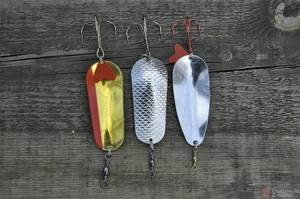
- Oscillating spoons do not allow you to effectively fish all water horizons in a reservoir. Oscillating spoons are designed for fishing in the water column. You cannot fish with a spoon on the surface of the water, like a popper, or in the area directly at the bottom, like with silicone baits on jig heads.
- Oscillating lures are cheaper than wobblers, but more expensive than silicone baits. For many anglers this is of significant importance.
- Oscillating lures without hooks allow you to fish in difficult places: among thickets of underwater vegetation and snags, but in such places the use of non-hooking rigs with silicone baits (Texas, Carolina, etc.) can be more effective.
You may be interested in: Kukan
Winter predator hunt
Sheer spoons are the main type of ice bait. The tactics of searching for pike consist in methodically examining promising points: snags, slopes, depth changes, reed edges, etc. The holes are drilled at a distance of 5-10m from each other, while the sludge is not cleared so that the sun does not illuminate the space under the ice. Pike spoons can be painted or have a pure metallic color. On a clear day, matte and dark tones predominate, while in cloudy weather, silver, gold and “acid” are used.
To learn more:
Twister bait: the subtleties of fishing for perch and pike
Armed with a fishing rod with a small inertia-free reel, you need to take care of a steel leash. Pike has sharp teeth that can bite even thick fishing line with a diameter of 0.5 mm. It is not used for pike perch, using fluorocarbon instead of steel. Along with girders, fishing for pike with spoons gives good results if the angler knows the characteristics of the predatory fish.
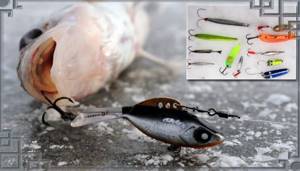
Choosing a spoon for pike
Pike are found in a variety of water bodies, in a variety of climatic conditions. The correct selection of bait suitable for specific fishing conditions determines the success of fishing. When choosing a spinner spoon for pike, you need to take into account many different factors.
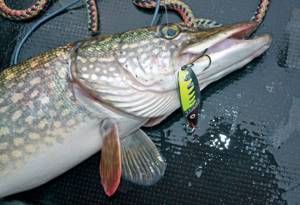
Pike spoons can have a wide variety of colors: from natural colors to the brightest acid colors, from dull metallic to shiny. All colors catch pike. The fisherman must choose the color of the spoon for a specific body of water, on a specific day. There is only one way to do this: trial and error.
The bait should be visible to fish in the water, so on a cloudy day it is better to use lures of brighter and more brilliant colors, and on a bright sunny day, darker and dull ones.
Shiny spoons attract pike well and can be very effective, but when fishing you should not use too highly polished spoons; they can scare off the pike with their too bright shine.
In clear water, black spoons show good results; they are clearly visible in the water and therefore very catchy.
Don’t be afraid to use large, oscillating spoons when fishing for pike. Spoons with a length of 7-8 to 12 cm show good efficiency when catching pike. In those reservoirs where there is a chance of catching a very large pike, the size of the spoon can be increased up to 15 cm.
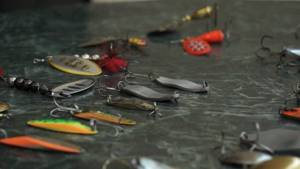
Pike prefer wide-shaped oscillating spoons; narrow and strongly curved spoons attract pike less.
When fishing for pike in spring and early summer, you should use medium-sized spoons. When fishing for pike in the fall, the size of the spoon should be increased; in the fall, before winter, pike actively feed and prefer larger prey.
The weight of the oscillating spoon is selected depending on the depth of the reservoir where fishing is carried out. Heavier spoons go deeper when retrieved, lighter ones go closer to the surface. The weight of the spoon depends on the material from which it is made and the thickness of the spoon itself.
When choosing a spoon for pike, purchase bait from a well-known, time-tested company, whose products will be distinguished by quality and reliability. Below we present the best lures for pike, the best manufacturers, choose your lure from this list.
Williams Wabler Trout Spoons
The versatility of Williams Wabler spinners has no limits; in the summer, on a regular monotonous retrieve, you just have to pause and the full potential of this spoon is revealed; its waddling glide causes an instant attack from almost any predator: salmon, lake trout, pike, pike perch. And in winter, the Williams Wabler will lure capricious pike perch at any time of the day, which likes to feed only in the mornings and at dusk in the evening. Recently, in winter, trout fishing on paid reservoirs and when hunting for walleye on Williams Wabler reservoirs has been unparalleled.
In the Wabler series of spinners: 38 colors
BDAP - Bad Apple/Silver back - Black/Yellow/Silver BKHL - Black Hole/Silver back - Black/Grey/Silver C - Yellow/Holography/Silver CAN - Candy Apple Nu-wrinkle/Silver back - Green Apple CDIC - Candied Ice /Silver back - Blue/Pink/Silver CGN - Purple/Flakes COP - Copper - Copper CRG - Purple/ DMD - Yellow&Red/Silver back - Yellow/Red EB - Electric Blue - Blue /Silver ENVY - Envy/Copper back - Orange /Light green/Copper F — Natural Frog/Silver back — Green/Yellow/Black FT — Firetiger — Green/Yellow/Red/Black FW — Fire Wabler — Red Holography/Silver G — Gold — Gold GCH — Gold/Chartreuse — Yellow/ Gold GHC - Gold Honeycomb - Honeycomb/Gold GLB - Glow Blue - Phosphorus/Blue/Silver GLDBO - Gold/Goldbo - Gold Holography/Gold GLG - Glow Green - Phosphorus/Green/Silver GN - Gold Nu-Wrinkle - Scales/Gold GOR — Gold Orange — Orange Holography/Gold H — Half&Half Mirror — Gold/Silver HN — Half&Half Nu-Wrinkle — Scales/Gold/Silver OB — Red/White/Ultraviolet OR — Fluorescent Orange/Silver back — Orange/Silver PK — Pink — Pink Holography/Silver RB — Rainbow Prism — Purple Holography/Silver RBT — Blue/Red/Silver RF — Ruffe/Silver back — Brown/Silver RSCH — Pink/Yellow/Silver RW — Red&White/Silver back — Red/White S — Silver Mirror - Silver SHC - Silver Honeycomb - Honeycomb/Silver SN - Silver Nu-Wrinkle - Scale/Silver WBRED - Wonder Bread/Copper back - White/Blue/Red WTML - Watermelon/Silver back - Pink/Yellow/Silver YO - Yellow&Orange/Silver back — Yellow/Orange
The following weights and sizes
1.8 g - 25 mm (Williams only produces 6 colors S, SN, G, GN, EB, FW) 2.8 g - 32 mm (Williams only produces 6 colors S, SN, G, GN, EB, FW) 4 g - 38 mm 7 g - 57 mm 14 g - 67 mm 21 g - 83 mm 28 g - 102 mm
Technique for catching pike with a spoon
Pike prefers slow and smooth movements of the spoon in the water. It is the leisurely movements of the bait that provoke the pike to attack. When retrieving, the spoon may lightly touch the bottom and even drag slightly along it, raising turbidity. Pike reacts very well to such actions of the fisherman, but such maneuvers can only be carried out in places where there are no snags and a bottom heavily overgrown with grass.
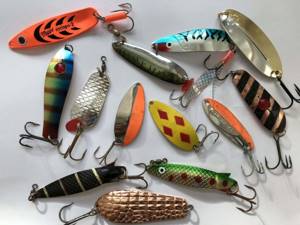
When retrieving, you can pause in reeling in the fishing line so that the spinner moves from side to side, provoking the pike to attack.
In especially deep places, you can use stepwise retrieval of the spinner, with pauses of up to 2-3 seconds.
When catching pike with a spoon, you should experiment more: change the fishing point more often, use spinners of different weights, change the color of the spinner more often. Such experiments will certainly bring good catches and with them fishing experience.
Oscillating lures and methods of placing them
Oscillating spoons, popularly called “oscillators,” are a type of active bait that requires a certain variety when retrieving. To increase the number of bites, breaks or changing leads are often simply necessary. Oscillating spoons perfectly complement twitching (jerk wiring).
Many spinning anglers often debate which bait is the most difficult to master. We believe that it is the most difficult to select wiring for oscillating spinners. And there are several reasons for this: oscillating spoons come in different shapes and sizes; there are high-quality and low-quality spinners; Many “modern” fishermen call the spoon the tackle of the distant past. And as a result, different spinning anglers have a separate opinion about the oscillating spoon: from “this bait is just class!” to “how can you even catch something like that?” Let's take a closer look at all the possible fishing methods when fishing with an oscillating spoon.
Uniform wiring
They also do it in the classic way: they throw out the tackle, let the lure sink to the desired depth, and begin to smoothly turn the reel handle. The design already includes the action of the bait - the spoon moves with a certain oscillation amplitude and a constant frequency. It should be noted that uniform wiring should be carried out in open areas where there are no snags and thick algae, in good light, when the water is clear and the predator has a good view.
Stepped wiring
This is another common wiring method. We throw out the tackle, let the spoon sink to the very bottom (if it is clean, without snags, algae, etc.), reel in a couple of meters of fishing line, simultaneously lifting the spoon and the rod. Stopping reeling, we lower the rod down - and the spoon goes deeper (the very moment when frequent bites occur). You can take your time with such wiring and carefully fish the entire area, even if the bottom is not entirely level. In addition, step-by-step wiring can be improved: shake the tip of the fishing rod, and also introduce the spoon with pauses and accelerations. The effectiveness will be obvious.
Snatch wiring – room for creativity
Twitching in the generally accepted sense refers to a wide variety of jerking methods. There are no limiting conditions that specifically indicate what and how to do. Different spinners have different profile deflections, which means different play. Simply put, jerk wiring needs to be selected for a specific spinner, trying to achieve the most attractive wiring for a predator.
Mastering the spinner
There is no point in randomly twitching the lure, trying to give it some kind of comical movements in the hope that they will provoke an attack from a predator. When mastering a new, unfamiliar spinner, you first need to find out how well it can withstand the depth of a uniform retrieve, how it works at different speeds, and how the game changes. Having identified these points, you can safely move on to twitching, remembering in detail what you did successfully and what did not. If even with a slow, smooth retrieve you cannot maintain its depth, everything else no longer plays any role - you are trying in vain. In conditions where the predator has poor visibility, quickly moving the spinner will be pointless. But it will work great in clear water.
Braking - acceleration
This is a type of twitching that provokes pike, perch and pike perch to take active action. We cast the bait, wait until the spoon falls to the bottom, evenly reel in the line with smooth acceleration, and then return to the initial version. For example: we make 10 slow turns of the handle, 5 fast turns, and then 10 slow turns again. With this type of wiring, the rod should remain motionless, only the reel works.
Short burst method
This method involves short accelerations with the rod, which can be calm, smoothly accelerating, sharp or the most sudden jerks. After casting the tackle, the spoon should sink to the bottom, and the rod should be raised up for 8-10 hours. Retrieving begins with a slight jerk of the rod, while the reel remains motionless. After the jerk, the rod remains raised up for about an hour, and during the remaining time the tip gradually lowers.
Yaw wiring
This method of wiring came to us from jerkbait fishing. It works well with many spinners. The wiring is similar to the previous one, however, jerks with the rod must be done alternately in different directions.
Mixed style
Fishing is a kitchen for creativity and improvisation. Great success is achieved by those fishermen who are not afraid to create something new. Combine all your skills and experience and come up with a new, original way of wiring that will surely bring you a good bite. And we wish you good luck!
